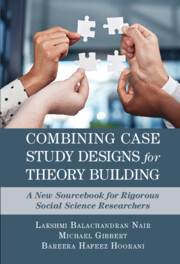 Combining Case Study Designs for Theory Building
Combining Case Study Designs for Theory Building Book contents
- Combining Case Study Designs for Theory Building
- Combining Case Study Designs for Theory Building
- Copyright page
- Contents
- Chapter 1 Introduction to Case Study Research
- Chapter 2 Building Blocks of Case Study Research
- Chapter 3 Of Talking Pigs and Black Swans
- Chapter 4 Do It Again
- Chapter 5 The Natural Experiment, a.k.a. the Single Embedded Design
- Chapter 6 Do It Again (and Again)
- Chapter 7 Sequencing Case Study Designs
- Chapter 8 More on Sequencing Case Study Designs
- Chapter 9 A Parting Note, on an Optimistic Note
- Index
- References
Chapter 3 - Of Talking Pigs and Black Swans
Single Holistic Case Study Design
Published online by Cambridge University Press: 02 February 2023
- Combining Case Study Designs for Theory Building
- Combining Case Study Designs for Theory Building
- Copyright page
- Contents
- Chapter 1 Introduction to Case Study Research
- Chapter 2 Building Blocks of Case Study Research
- Chapter 3 Of Talking Pigs and Black Swans
- Chapter 4 Do It Again
- Chapter 5 The Natural Experiment, a.k.a. the Single Embedded Design
- Chapter 6 Do It Again (and Again)
- Chapter 7 Sequencing Case Study Designs
- Chapter 8 More on Sequencing Case Study Designs
- Chapter 9 A Parting Note, on an Optimistic Note
- Index
- References
Summary
We introduce and define the single holistic case study design in this chapter. The strengths of the design are discussed in detail, with examples. In particular, we discuss the potential of single holistic design in providing a detailed explanation of processes. Single holistic case studies also explore the theorizing potential of unique cases which hold the potential to reveal new dimensions of a phenomenon or falsify/refute an existing theory. Relatively high data access, construct validity, potential to include an unlimited number of variables, etc., are some other strengths that we discuss. The weaknesses of the design (i.e. low internal and external validity) are discussed afterwards. The chapter also addresses some common (mis)conceptions regarding single holistic designs and their external validity.
Keywords
- Type
- Chapter
- Information
- Combining Case Study Designs for Theory BuildingA New Sourcebook for Rigorous Social Science Researchers, pp. 31 - 49Publisher: Cambridge University PressPrint publication year: 2023
